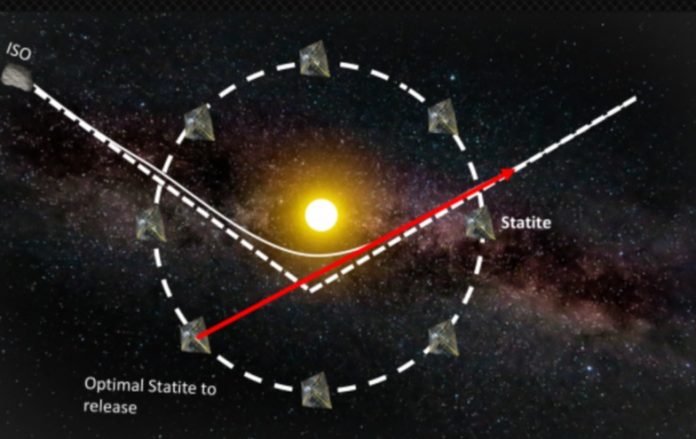
In 2017, a telescope in Hawaii detected our first celestial visitor from another solar system — a big deal, since we haven’t quite figured out how to visit them ourselves yet.
‘Oumuamua, the cigar-shaped interstellar object (ISO) whose name roughly translates to “first distant messenger” in Hawaiian, will certainly not be the last visitor to pass through.
If the story of our universe is written in the stars, even a tiny fragment traveling a long way for a short visit provides a tremendous opportunity for scientific discovery.
But in order to get close enough to read the next piece of the story that wanders onto our doorstep, we will have to catch it first.
To closely observe an ISO hurtling through space, time is of the essence.
Richard Linares, an assistant professor in the Department of Aeronautics and Astronautics (AeroAstro) at MIT, developed a concept for a “dynamic orbital slingshot for rendezvous with interstellar objects.”
He outlined his idea in a research proposal that was recently selected as a Phase 1 study in the NASA Innovative Advanced Concepts (NIAC) Program, which “funds innovative aerospace concepts that could enable and transform future missions.”
“There are a lot of fundamental challenges with observing ISOs from Earth — they are usually so small that light from the sun needs to illuminate it in a certain way for our telescopes to even detect it,” said Linares, who is the director of the Astrodynamics, Space Robotics, and Controls Laboratory, part of the Space Systems Laboratory in AeroAstro.
“And they are traveling so fast that it’s hard to pull together and launch a mission from Earth in the small window of opportunity we have before it’s gone. We’d have to get there fast, and current propulsion technologies are a limiting factor.”
To eliminate these barriers, Linares instead proposes using statites, or “static satellites” enabled by a solar sail constructed with just the right mass-to-area ratio.
A thin enough sail with a large enough surface area will have a low enough mass to use solar radiation pressure to cancel out the sun’s gravitational force no matter how far away it is, creating a propulsive force that allows the statite to hover in place indefinitely.
Linares envisions deploying a constellation of statites to act as interstellar watchdogs along the edges of our solar system, lying in wait until roused by an ISO crossing our threshold.
Once detected, the solar sail then enables the statite to switch gears quickly and spring into action.
Since the statite has a velocity of zero, it is already in position for efficient trajectory. Once released, the stored energy in the solar sail would leverage the gravitational pull of the sun to slingshot the statite in a freefall trajectory towards the ISO, allowing it to catch up.
If the timing is right, the statite could tag the ISO with a CubeSat armed with onboard sensors to orbit the ISO over an extended period of time, gathering important scientific data.
“Flyby missions tend to be easier because they don’t require you to slow down — you fly past the object and try to get as many pictures as you can in that window,” says Linares.
“A rendezvous mission is harder because you have to slow down and match the speed of the object so you can stay with it for a while. But the longer you can stay around the interstellar object, the better pool of data you can collect. Good science happens up close.”
For this project, Linares is working with fellow MIT faculty members Paulo Lozano, professor of aeronautics and astronautics and director of the Space Propulsion Laboratory; and Benjamin Weiss, professor of planetary sciences in the Department of Earth, Atmospheric and Planetary Sciences; as well as Damon Landau at NASA’s Jet Propulsion Laboratory.
Over the next nine months, Linares and his fellow investigators will determine the feasibility of their idea, how to evaluate the performance of their system, and develop a concept for a potential mission.
“Studying an interstellar body close-up would revolutionize our understanding of planet formation and evolution,” says Weiss.
“For the first time, we could obtain sensitive measurements of the bulk composition of other solar systems. We could also learn how quickly and how commonly objects transit between solar systems, which will tell us the feasibility of the interstellar transfer of life.”
The Phase 1 designation under the NIAC program establishes a proof-of-concept for out-of-the-box ideas over a nine-month period of viability studies. Investigators can subsequently apply for Phase 2 and Phase 3 awards under the NIAC program to further develop their concepts over a longer period of time.
“Winning a NIAC award such as this one is very prestigious, but also very difficult, because the proposer has to walk a fine line between an innovative idea that sounds almost like science fiction while being grounded in real physics,” says Olivier de Weck, a professor of aeronautics and astronautics and of engineering systems at MIT.
“Professor Linares and his colleagues have done this perfectly, and this concept will enable the study of ISOs in an unprecedented way by essentially balancing out the two major things we get from our sun in new ways: gravity and radiation.”
Written by Sara Cody.



